Photographs: Brian Snyder/Reuters Anand Sankar
Indian bikers have never had it so good. Top names in the business want to launch in the leisure segment. The temperature just got a few degrees hotter when Harley-Davidson, the American icon, announced its entry through a wholly-owned subsidiary, Harley-Davidson Motor Company India.
The Indian operations will be spearheaded by Anoop Prakash, an American of Indian origin who has come straight from the administration of former President George W Bush, and Managing Director, Harley-Davidson India.
Prakash knows that he is a newcomer to the extremely competitive world of motorcycles and the challenge of making Harley a household name and an everyday sight in India is tough. Still, he is on the lookout for the right commercial real estate in Gurgaon to set up his office.
He wants a space which can house an office, showcase his motorcycles and associated merchandise (not retail them though), hold events and be near the highway so that enthusiasts can test the motorcycles.
He says the Harley experience will begin right at his office. Read on for excerpts from the interview wtih Prakash. . .
Mangoes for the US, but Harley-Davidson for India!
Image: A classic Harley-Davidson motorcycle.Photographs: Courtesy, Harley-Davidson Motor Company Archives. Copyright H-D
How did the 'Harley for Indian mango' trade deal happen in 2007?
An understanding had to be reached between the US and India that we are not coming here to compete with the domestic market. We are coming here to build and serve a whole new market segment.
Once there was an understanding there, we had to discuss it. Thus, during the trade negotiations, you had two national icons being exchanged.
It is a cruel punishment to not have Americans experience Indian mangoes and Indians not experience Harley.
Mangoes for the US, but Harley-Davidson for India!
Image: The iconic Harley-Davidson logo on a motorcycle.Photographs: Courtesy, Harley-Davidson Motor Company Archives. Copyright H-D
Why did it take two years for Harley to get here?
Only at the point where the barrier for heavyweight motorcycles was lifted could we legitimately as a listed company make an investment strategy. If you can't come in, why spend a lot of energy developing strategy? So, from that point, there was very serious research and study.
Many trips to India by Harley executives happened, some even incognito. We met people in the industry. We have become quite close to our friends at Royal Enfield and others have welcomed us. It took so long to research because we took a ten-year view.
If we had come in at a transaction level, it would have been very easy to find a distributor and say "go figure out the brand and call us when you have the volume; till then we will keep sending you stuff." That is an ignorant approach.
This is the first time in any market that Harley has entered using a wholly-owned subsidiary. We are bringing the full experience and not taking shortcuts. Anything less will not satisfy the company or the rider.
Mangoes for the US, but Harley-Davidson for India!
Image: Bikers ride their Harley-Davidsons.Photographs: Morris Mac Matzen/Reuters
The motorcycles are effectively going to cost twice as much as in the US, thanks to the high tariff.
There was a lot of uncertainty whether or not the tariff would make the investment worth it. Like any company that has been around for a while now, we have nurtured the brand and done things carefully.
We didn't want to come in, make some noise and be transactional. We wanted to study the market and make sure it was the right price. Chapter II of the riding market -- leisure riding -- is shaping up now.
The tariff challenge unfortunately is going to keep the motorcycle out of the hands of some of our enthusiasts in the initial stages. It is not protecting the domestic producer and there is no Chinese producer, so you can't use that argument either.
Effectively, this is a tax on what is being perceived by the government as luxury goods. Unfortunately, the world over it is not. A motorcycle is an emotional purchase. It transcends socio-economic backgrounds.
The duty structure will remain at the top of the agenda during trade discussions. It is critical for job growth here as well as in the US.
If you can establish dealerships and retail businesses here, you will create a tremendous amount of jobs. The average US dealership has 200 employees.
Mangoes for the US, but Harley-Davidson for India!
Image: A Harley-Davidson patch is for sale at a bar during a Bike Week event in Samsula, Florida.Photographs: Rick Wilking/Reuters
How do you plan to bring in the bikes and what models?
Right now we are going to import as completely built units. We really want to understand India better. We have different scenarios projected for India.
We know there is a lot of enthusiasm but the import tariff is a reality. We also want to have models on Indian roads and give feedback back home. And then we will know what path to take.
Do we need to start looking at parts and accessories that are for Indian roads or we build a kit where we can modify a US or Euro motorcycle to Indian standard? We are looking at completely knocked down kit options later to allow us to turn volume faster and bring price down.
Do we start looking at products for Indians, built for India? It is premature to look at those now.
We are bringing the full range of Harley families (seven) to India. We will not bring all the 43 models, but there will be at least one from each family, if not two. We are targeting 12 to 15 unique models. We want to hear from riders here what they want to see in 2010.
Mangoes for the US, but Harley-Davidson for India!
Image: The VRSCF V-Rod Muscle from Harley-Davidson.Photographs: Courtesy, Harley-Davidson Motor Company Archives. Copyright H-D
What will be your consumer finance strategy?
With respect to financing, I am looking at the portfolio and saying what can I do on our pricing ladder to maybe make some of our bikes a little more affordable and have more appeal?
My job is to make sure that most people access the brand. We want to provide the best consumer finance options. I am looking at every possible approach and modelling across our portfolio.
Mangoes for the US, but Harley-Davidson for India!
Image: The LSTF Softail Fat Boy from Harley-Davidson.Photographs: Courtesy, Harley-Davidson Motor Company Archives. Copyright H-D
Won't buyers gain confidence if you start manufacturing here?
That is the longest-term scenario, requiring the biggest investment. We have to prove that everything is as we say it is in India -- it is growing, it is rich and it is healthy. Now, we are going to bring the world-class Harley experience to India.
What that has meant for us is extremely close attention to the rider's needs. It could be getting a part or an accessory shipped from a dealer in the US or Europe overnight.
They should be able to rely on Harley to be there for them for all their riding needs. We are going to take the entire industry's service expectation up a notch.
We are not going to dumb down the service offering because it is not the standard here.
Mangoes for the US, but Harley-Davidson for India!
Image: The FLHR Road King from Harlye-Davidson.Photographs: Courtesy, Harley-Davidson Motor Company Archives. Copyright H-D
What is the retail and service model going to look like?
The model is going to have independent dealers who will be responsible in their territory for sales and after-sale service. We are definitely going to provide training.
As far as service is concerned, we are considering different models. How do you deliver service outside the city? In the US, we have 600 dealers, so we have enough density. We need to develop something here to make sure we serve the rider wherever he rides.
To do that we are learning the lessons that other manufacturers have learned -- having gone through dealers first and not having service later. I have learned from that to make sure we are not in that position.
Mangoes for the US, but Harley-Davidson for India!
Image: The 2008 VRSCAW.Photographs: Courtesy, Harley-Davidson Motor Company Archives. Copyright H-D
Harley Davidson's revenue from apparel and accessories has been growing steadily globally. Is there a separate plan for it in India?
Globally, I believe, the apparel business is now 15 to 20 per cent. Accessories (custom parts) are about 20 per cent. Motorcycles are the rest.
We are closely looking at how we deliver a line of apparels in India and for India. In the future, this can also serve the rest of the world as India has a rich apparel design and manufacturing industry.
We expect Harley retail points that are not dealerships to be used for apparel and general merchandise.
We will have single brand stores in malls or markets so that those who cannot access the motorcycles, can access the brand. We will keep the dealers focussed on bikes and riding gear -- everything that the rider needs.
Mangoes for the US, but Harley-Davidson for India!
Image: The 2009 XL 883C Sportster 883 Custom.Photographs: Courtesy, Harley-Davidson Motor Company Archives. Copyright H-D
How will the advertising plan roll out?
I want all enthusiasts to look and feel for themselves what it is to ride a Harley. We already have an incredible amount of people registering on our website to be informed about events and rides.
We want to reach out to as many and as quickly as we can. So, I believe at the front end there is not a lot of value in advertising in the traditional sense.

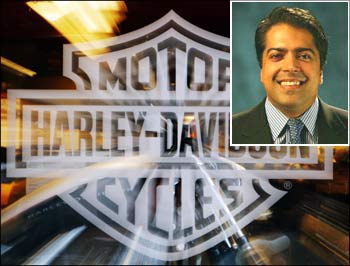
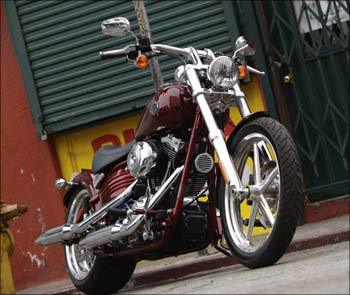
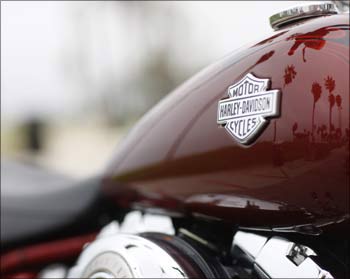
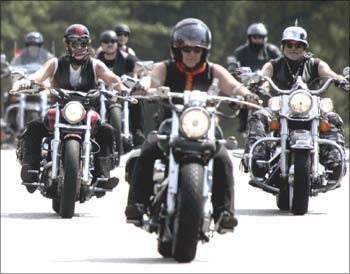
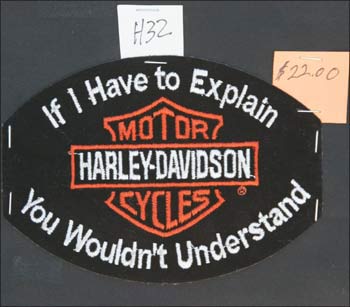

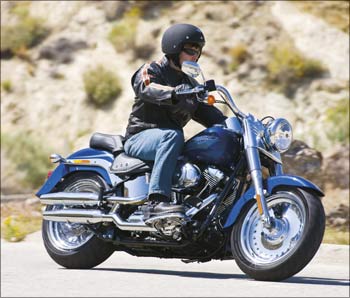
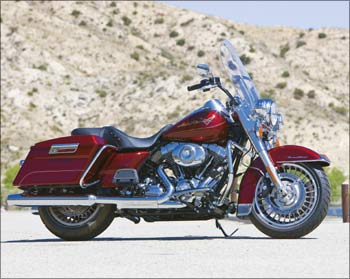
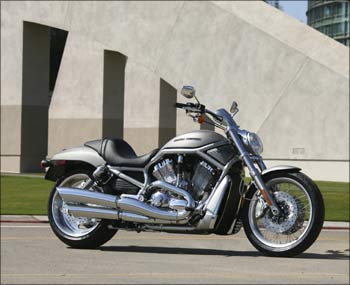


article